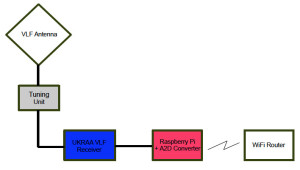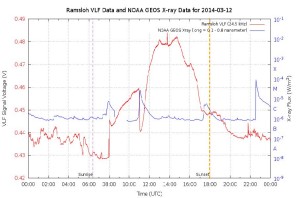March 15, 2014
Notes On Setting Up a Sudden Ionospheric Disturbances (SID) detection Station using a Very Low Frequency (VLF) Receiver
Report by Clive Inglis
The Flamsteed SID detection system uses a VLF receiver and a small loop antenna purchased ready-built from the United Kingdom Radio Astronomy Association (UKRAA). A detailed description of SID detection and the UKRAA VLF Receiver system can be found on their web-site: http://www.ukraa.com/www/vlf-range.html.
The UKRAA website states: “The receiver has a tuning range of 12kHz to 35kHz and provides a variable output voltage of 0-2.5v and 0-5v. The output voltage may be fed to any data logger or digital multimeter or suitably equipped computer.
The receiver requires a supply of 15 Volts DC at 35mA. UKRAA supplies a small loop aerial and tuning unit suitable for indoor use in moderate signal areas. Larger outdoor tuned aerials of either the loop, or “long wire” format may improve reception, and possibly reduce interference.
The receiver is supplemented with various other items of equipment such as the VLF Signal Generator tuned for 23.4kHz and an Exciter loop to test the directional sensitivity of the VLF Aerial.”
A simple schematic of the Flamsteed Radio Group’s SID detection system is shown below:
The analogue signal output from the VLF receiver is connected to an Analogue to Digital Converter (ADC) fitted to a Raspberry Pi (RPi ) model B single board computer a detailed description of which can be found at: http://en.wikipedia.org/wiki/Raspberry_Pi.
The “Pi “ is powered by a 5V, 1A power adaptor and maintains a Wi-Fi connection to the internet via a Wi-Fi extender and router.
The ADC is an ADC Pi V2.2, an 8 channel 17 bit analogue to digital converter designed to work with the RPi and was purchased from AE electronics. (http://www.abelectronics.co.uk/products/3/Raspberry-Pi/17/ADC-Pi-V2—Raspberry-Pi-Analogue-t o-Digital-converter ).
The Raspberry Pi runs Raspbian as an operating system, a specialised distribution of Debian Linux which supports Python and Gnuplot. Python 3 code has been written to sample the analogue VLF receiver signal at 5 sec intervals using the ADC Pi library routines and then to write the data into files on the Raspberry Pi’s SD card. Gnuplot is used to create a daily plot of the VLF data along with the corresponding 24hrs worth of X ray data. The X ray data is downloaded from the NOAA website: ftp://ftp.swpc.noaa.gov/pub/lists/xray
This data is download at 3am each day when the previous day’s X ray data becomes available, using File Transfer Protocol (ftp). The resulting plot is a .png format file which is then uploaded to the Flamsteed website also using ftp. The scheduling of VLF data acquisition, Xray data download, plotting and plot upload to the website is controlled by a shell script running on the RPi. The Pi’s operating system’s clock and therefore the scheduling is kept accurate by linking to Network Time Protocol (NTP) servers via the internet connection: http://en.wikipedia.org/wiki/Network_Time_Protocol
Below is a typical Flamsteed VLF Receiver plot showing the time of sunrise and sunset line markers and two SID events. The first, a C class event occurs at 11:00 and is detected by the negative excursion on the red VLF trace. This events correlates to the increase in the X ray flux shown on the blue satellite data trace. The second, an M class event occurs at 22:30 and is detected by the satellite but not by the VLF receiver due to the fact that the sun has set and the Ionospheric D layer has dispersed.
The Flamsteed VLF receiver uses the UKRAA small loop aerial and aerial tuning unit which are only suitable for indoor use, therefore the antenna is sited close to the VLF Receiver within a garden shed. Another suitable indoor location would be a loft or attic or any “electrically quiet” indoor location, free from electrical interference.
How to set up and tune the VLF Receiver is described in detail in the UKRAA VLF Receiver Manual which can be downloaded from their website: http://www.ukraa.com/www/downloads
The manual explains why ideally the transmitter should be between 700km and 1000km from the receiver. UKRAA suggests that initial tuning should be to a VLF station giving a strong signal. For a receiver located in the south east of England the Ramsloh Transmitter situated in Northern Germany gives a strong signal at a frequency of 24.5kHz despite being less than 700km distant.
The UKRAA can supply a signal generator at this frequency to assist in tuning the receiver. A list of frequencies currently being used by SID observers can be found at: http://sidstation.loudet.org/data-en.xhtml .
It is not a complete list of available signals, but may prove useful in initial tuning of the receiver and testing of the complete VLF system. The Flamsteed VLF Receiver is currently tuned to the Ramsloh transmitter. Occasionally this transmitter is switched off for maintenance and during this down time we are unable to gather SID data. To maintain coverage and possibly improve SID detection it would be desirable to monitor more than one transmitter using additional VLF receivers.
The BeagleBone Black has been investigated as an alternative single board computer to the Rpi. (Details of the BeagleBone can be found at: http://beagleboard.org/Products/BeagleBone+Black.) The BeagleBone black has 7 analogue inputs (1.8V max. 12 bit A/D converters) and a faster processor than the RPi. It uses Angstrom as its operating system, another Linux distribution, and the Python VLF data gathering code developed on the Raspberry Pi has been successfully run on a BeagleBone Black. However, in testing to date it has proved to be less “robust” than the Raspberry Pi.
Posted under: Flamsteed, Radio Astronomy





You must be logged in to post a comment.